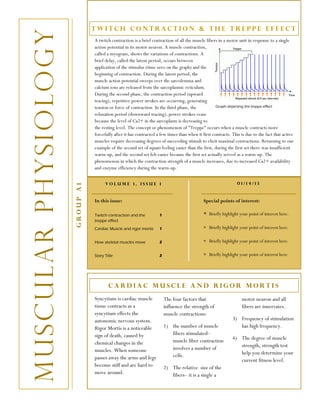
Muscle artifact
- 1. Twitch Contraction & The treppe effect M u s c u l a r p h ys i o lo g y A twitch contraction is a brief contraction of all the muscle fibers in a motor unit in response to a single action potential in its motor neuron. A muscle contraction, called a myogram, shows the variations of contractions. A brief delay, called the latent period, occurs between application of the stimulus (time zero on the graph) and the beginning of contraction. During the latent period, the muscle action potential sweeps over the sarcolemma and calcium ions are released from the sarcoplasmic reticulum. During the second phase, the contraction period (upward tracing), repetitive power strokes are occurring, generating tension or force of contraction. In the third phase, the Graph depicting the treppe effect relaxation period (downward tracing), power strokes cease because the level of Ca2+ in the sarcoplasm is decreasing to the resting level. The concept or phenomenon of "Treppe" occurs when a muscle contracts more forcefully after it has contracted a few times than when it first contracts. This is due to the fact that active muscles require decreasing degrees of succeeding stimuli to elicit maximal contractions. Returning to our example of the second set of squats feeling easier than the first, during the first set there was insufficient warm-up, and the second set felt easier because the first set actually served as a warm-up. The phenomenon in which the contraction strength of a muscle increases, due to increased Ca2+ availability and enzyme efficiency during the warm-up. Volume 1, Issue 1 01/14/13 Group A1 In this issue: Special points of interest: Twitch contraction and the 1 ∗ Briefly highlight your point of interest here. treppe effect Cardiac Muscle and rigor mortis 1 ∗ Briefly highlight your point of interest here. How skeletal muscles move 2 ∗ Briefly highlight your point of interest here. Story Title 2 ∗ Briefly highlight your point of interest here. Cardiac muscle and rigor mortis Syncytium is cardiac muscle The four factors that motor neuron and all tissue contracts as a influence the strength of fibers are innervates. syncytium effects the muscle contractions: autonomic nervous system. 3) Frequency of stimulation Rigor Mortis is a noticeable 1) the number of muscle has high frequency. sign of death, caused by fibers stimulated– muscle fiber contraction 4) The degree of muscle chemical changes in the strength, strength test muscles. When someone involves a number of cells. help you determine your passes away the arms and legs current fitness level. become stiff and are hard to 2) The relative size of the move around. fibers– it is a single a
- 2. How skeletal muscles move Skeletal muscle moves bones by receiving acetylcholine from a motor nerve that triggers an action potential across the muscle fibers. Muscle fibers contain actin and myosin, which are the function components of muscle contraction. Movement of a bone occurs when the muscle attached is being shortened. The chemical reactions that cause muscle contraction generate heat - energy conversion always generates "useless" energy; entropy increases. Structures unique to the skeletal muscle fibers The structures that are unique to the skeletal The functions of a myofilament is to pull out muscle fibers are M-Line, A-Band, I-Band, and every myofibril and the myofilaments and see H-Zone. all of the actins and mysins. - M-Line: Thin line all the way through 5. The sliding of a filament theory is how the muscles produce, when you have thin and thick - A-Band: tells the length of the myosin (also filaments that slide past one another as you stays the same when a muscle contracts) work out and that’s what makes your muscles eventually get stronger. - I-Band: Distance between the myosins - H-Zone: Distance between Actin between same molecule. (Shrinks when muscle contacts) The H-Zone and I-Band are contractile because they shorten. The M-Line and A-Band are Excitability